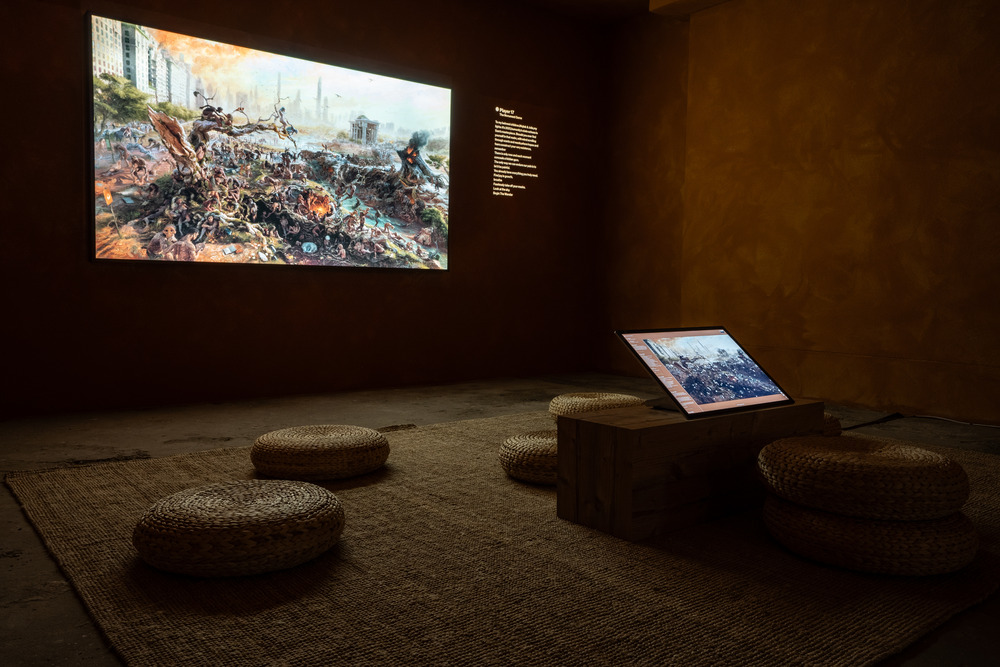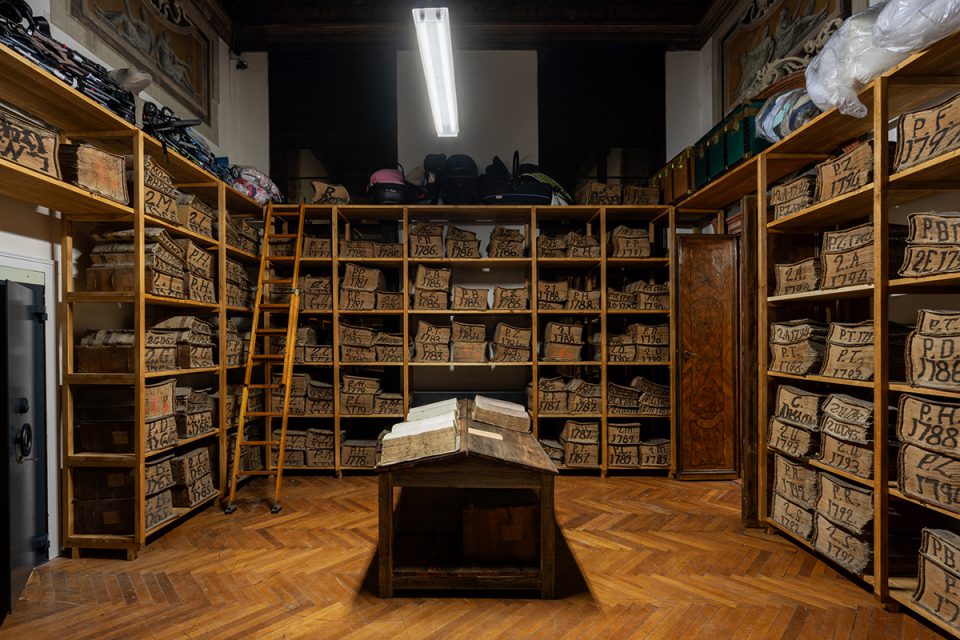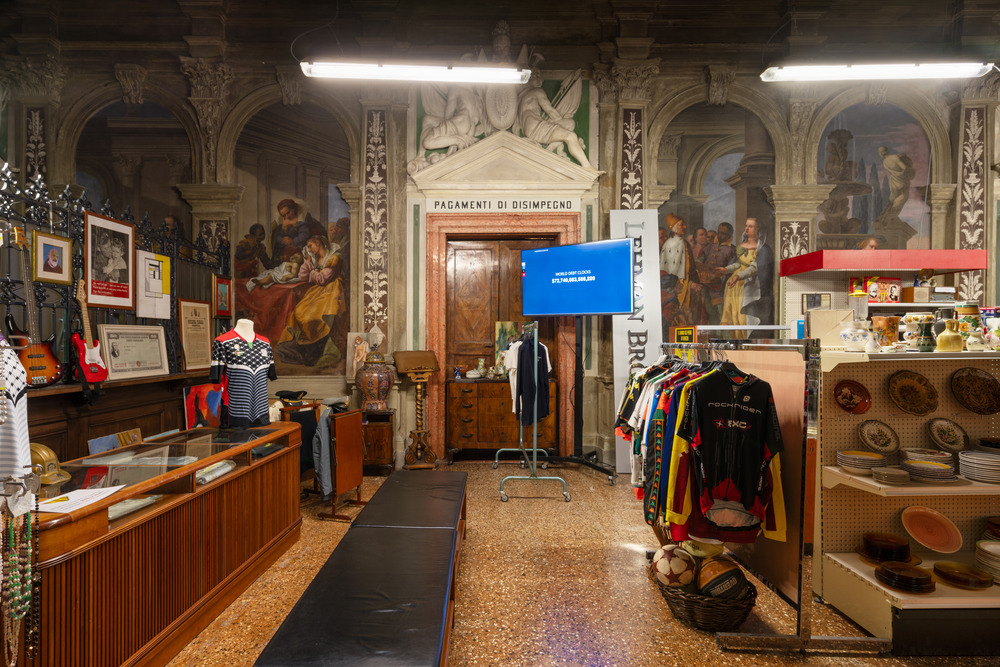Economic Provenance and the Audit Problem
How can expertise from time-based media art conservation help appraisers vet NFTs?


Not long after I arrived in Venice for the sixtieth edition of the Biennale, the art world’s most extravagant and venerated exhibition, my friend messaged me with the questions that really matter: “How are people looking this year? Survivor-like or pretending to be still rich?” I reported that they are most definitely still pretending to be rich. The art world was turned out in its finest attire. She was not surprised. It was preview week and, as she and I both knew, we were all here to play dress-up.

I snapped pictures of a woman sporting a dowdy, close-cropped haircut and tweed pauldrons, in a style I call “Angela Merkel x Prada.” It’s a good look. Nearby, a mauve corduroy pantsuit, hot pink blouse with oversized lapels, and aggressively functional Asics running shoes. I call this “thrift store adjunct DeGeneres.” It’s a bad look. The men’s fashion was mostly hewing to the standard “hedge fund guy, but this one fucks” aesthetic.
I was, naturally, bucking this trend. I was meticulously prepared for art’s great pageant, having planned my wardrobe weeks in advance. For my first day of preview week, I set aside Issey Miyake culottes and a Yohji Yamamoto faux-cape. The top is more like a flying squirrel costume, to be honest. It’s a tight-fitting black mohair sweater with extra triangles of material filling in the space between the arms and torso. When I stand arms akimbo, I look as though I’ve been poorly photoshopped into my surroundings, like someone forgot to deselect the negative space under my arms before copy-pasting me into the scene.
If there is a fashion theme at this year’s Biennale, it’s that exhibitors and participants wear their politics on their sleeves.
This outfit felt appropriate as I stood outside the Netherlands pavilion, where a crowd cheered as a Dutch arts administrator passed the microphone to a member of the Congolese Plantation Workers’ Art League, to whom the European nation has ceded control of its pavilion this year. I couldn’t totally hear what they were saying, but I caught the gist of something anti-colonialist and I am also anti-colonialist so I also cheered. Later, I waited in line outside the Austria pavilion, where a manicured crowd of hundreds applauded a speech protesting the war in Ukraine. If there is a unifying fashion theme across this year’s Biennale, it is the insistence that exhibitors and participants alike wear their politics on their sleeves.
#
On my third day in Venice, the NFT crowd finally arrived. Bright Moments presented Dream Cathedral, a new interactive AI video piece by Ganbrood and Huemin dressed to perfection in a fifteenth-century church. Visitors were invited to kneel at the altar and whisper their sins into a microphone, then watch the AI video model illustrate them in real time. It’s an admirable example of an artwork tailored to fit its rather imposing surroundings.
Elsewhere, Sam Spratt’s exhibition in the ex-industrial gallery space of Docks Cantieri Cucchini, organized by 1of1’s deft and intelligent curator Lukas Amacher, is gorgeous. The work glows—literally—as large-scale lightboxes, matched in luminosity by a wedge of Venetian light bouncing around the space. The walls are painted in the earth tones that dominate Spratt’s wardrobe.
It has been interesting to observe which art world trends the NFT crowd has adopted, and which it has eschewed.
It has been three years since the crypto community first started crashing the art world’s biggest events. In that time, it has been interesting to observe which art world trends the NFT crowd has adopted, and which it has eschewed. The most popular crypto art bears little aesthetic resemblance to what’s on at fairs and biennials. It’s hardly ever overtly political. When identity politics is on display, it tends to be presented as aspirational rather than problematized—celebrating women in generative art, for instance. The crypto art world doesn’t seem to have much interest in mimicking the aesthetics found inside the Arsenale, but it does intuitively recognize the pomp and accoutrement of these events as art’s most accessible expression—and source—of power.
#

My family rarely accompanies me to art world events (too stuffy, too many hands to shake, too much networking to do), but this week they did, and I brought my wife and my sister along to the Bright Moments party. It felt comfortable and, well, familial.
A lot of this may have had to do with the dressed-down atmosphere of the crowd. My sister, who has never engaged with crypto, notes “everyone is wearing cute 8-bit shirts,” a reference to the fan merch uniforms of NFT communities. Out of context it might look tribalistic, even silly, but it also feels authentic. It’s definitely comfy. Take away the splendor of the surroundings, strip away the pageantry, and this is the very best of the scene: warmth, earnestness, enthusiasm, optimism.
Amid all this, I felt a bit silly in my own outfit. My jacket was a runway sample from Rick Owens F/W 2020 show, and I paired it with a Comme des Garçons top which is half torn, leaving a trail of pseudo-coattails streaming behind me. I had somewhere else to be that evening, and it was imperative that I dress the part.
I was on my way to the Fondazione Prada, for the opening reception of Christoph Büchel’s exhibition “Monte di Pietà,” in which I have a small role (the exhibition includes my 2017 artwork Digital Zones of Immaterial Pictorial Sensibility, an early tokenized artwork that translates a similarly named 1962 work by Yves Klein into Ethereum’s Solidity programming language). Like almost everyone else, I had no idea what to expect. What I found there was a bold and brilliant undressing of both the art and crypto worlds.
#
The exhibition spreads out over three stories of the Fondazione Prada’s baroque palazzo. From 1834 to 1969, the building was operated by the Catholic Church as a Monte di Pietà: a financial institution somewhere between a bank and a pawn shop. The church would extend loans to the needy backed by collateral left by the loanee, often their most valuable personal effects: their clothes.
This site-specific history undergirds Büchel’s exhibition conceptually and literally: the first floor of the building is presented as a bankrupt pawn shop. It’s full of old furniture and equipment unceremoniously draped in vinyl tarps, ready to be sold off at steep discounts via the dusty auctioneer’s table. Büchel then embarks on an uncompromising journey through value creation and debt: its history, tactics, and consequences.

The second floor is almost entirely focused on cryptocurrency’s cycle of value creation and value capture. Soon after stepping off the stairs, I was blasted by the radiant heat of a crypto mining rig that takes up an entire wall. In the same room, a copy of Satoshi’s Bitcoin whitepaper is pinned to a cubicle partition.
The exhibition quickly shifts gears, from crypto mining to crypto pumping. Two rooms down you enter a social media influencer’s studio, with lighting, a makeup table, and wardrobe racks. On the final rooms of the floor (or maybe the first ones, depending on which door you came in), the cycle is completed on the roulette wheels and poker tables of a speakeasy casino.
Büchel’s crypto-bro mise-en-scène is unflattering, but it’s different from the knee-jerk rubbernecking of perfunctory critiques of crypto culture.
When I finally found my own artwork, I laughed out loud. A Ledger hardware wallet is strewn carelessly between a PS3 running Spec Ops: The Line and a PS4 running Fortnite. My Digital Zone token is on that wallet, which is connected to a laptop displaying the artwork in its original, unwrapped, blank-screen form. It’s the only evidence of an actual NFT I can find anywhere in the show, and its presentation is brutally unceremonious compared to the elaborate stagings I soaked in earlier that day.
Büchel’s crypto-bro mise-en-scène is unflattering to all its participants, but it somehow feels different from the knee-jerk rubbernecking that characterizes perfunctory critiques of crypto culture. The depth of research and commitment to nailing the little details is evident everywhere, from the LED lighting on the mining GPUs to the choice of gaming chairs furnishing the spaces. There are no mentions of Sam Bankman-Fried, nor are there facetious displays of cringeworthy NFTs. Büchel focuses on the mechanisms of cryptofinance, rather than its symptoms, in order to place them in a grand history of other mechanisms designed to extract value from their true believers. The Catholic Monte di Pietà, on the first floor, is one such analogous machine. On the third floor, in the show’s most vicious critique and its ultimate punchline, Büchel shows us another: art.
Like the other parts of the exhibition, the third-floor pawn shop offers no didactic wall text, no labels, and no wink to the audience. There is no hand-holding. The entire exhibition is so cluttered with racks, vitrines, and piles of junk that even the baroque authority of the architecture seems to disappear. Unlike on the other floors of the exhibition, there are specific, discrete artworks in here—masterpieces, even—but they’ve been stripped naked, denied the dressings that almost always allow us to identify them as such. I walked past one vitrine and noted the used Donald Trump boardgame multiple times before I noticed that the Heinz kosher dill pickle jar just behind it is, in fact, Andy Warhol’s Heinz Kosher Dill Pickles Jar (ca. 1974). The oil painting unceremoniously hung on a pegboard behind the counter? I didn’t recognize it as a Titian, on loan from the Uffizzi Gallery, until it was pointed out to me.
The presentation of these artworks foregrounds how these pieces are mere artifacts that become stores of value in a complex global economy.
The effectiveness of the presentation goes beyond the novelty of seeing an exhibition-as-treasure-hunt. The presentation of these artworks foregrounds the ways that these pieces are mere artifacts that, through some magic alchemy, become stores of value in a complex global economy. All the themes previously established on the Catholic and crypto floors of the exhibition are echoed here, in the art world context, if you look hard enough.
There are a couple artworks hidden on this floor that put a fine point on art-as-financial-instrument thesis. Marcel Duchamp’s Monte Carlo Bond (1924), an artwork which is quite literally a financial security (Duchamp sold editions to collectors to finance his gambling), is casually hung behind a workstation tuned into the Bitcoin halving. Yves Klein’s own receipt for The Void—part of his Immaterial Zones of Pictorial Sensibility, which I have long argued is the first ever nonfungible token art and which inspired my own work in the show—is lying around somewhere, if you can find it.

And of course, there are clothes. Heaps of them, piles of them, presented the same way as the art: as undifferentiated piles of stuff, some of which might be worth something. This is a bonfire of the vanities, and it is the boldest and most memorable presentation of art I’ve ever seen.
Occasionally Büchel weaves in glimpses of these financial machines’ real output. Where he does, he serves up his politics in a similarly ambiguous style—which is to say, unfashionably. Tucked away in a side room on the first floor, a recreation of a bombed-out Palestinian “Memories Museum” is the exhibition’s first of many such gestures. A workstation in the crypto mining room is exploring a metaverse art exhibition called “META HISTORY: NFT-Museum of Ukrainian War.” That third-floor pawnbroker’s office is dedicated to the study of the identification of classical art at one desk, and the history of the slave trade at another. The connection between value extraction and global conflict is always present in this exhibition, but when it’s identified, there’s no applause. No wearing it on the sleeve.
#
The day after the opening reception, I returned to the show with a chunk of the Bright Moments community, and to my surprise, about two dozen showed up with a real appetite for the exhibition. On this, my final day in Venice, I put aside the canary yellow Burberry blazer I’d prepared (“hedge fund guy, but this one fucks”) in favor of simple gray jeans and a cotton sweatshirt with the logo of JPG, the defunct curatorial protocol—now that I think about it, it was part of an actual liquidation sale. I trade in my Rick Owens shoes for the Asics Gel Lyte IIIs that I normally wear running dad-core errands at home. The only embellishment is a “cute 8-bit” CryptoVenezian pin that was gifted to me by the Bright Moments team, which I wear proudly. I don’t need the fashion flex anymore. The work can speak for itself.
Mitchell F. Chan is an artist based in Toronto.
